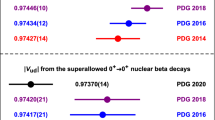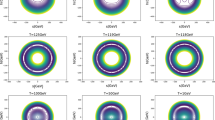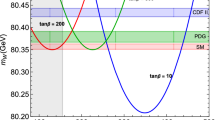Abstract
Within the framework of the confinement mechanism proposed earlier by the author in QCD the problem of masses for fundamental fermions in particle physics is discussed by the example of τ-lepton τ −. It is shown that the observed parameters of τ-lepton such as its mass and magnetic moment can be obtained in a preon model dynamically due to a preon gauge interaction. The radius of τ-lepton is also estimated. Under the circumstances preons might be massless in virtue of existence of the nonzero chiral limit for the preon interaction energy.


Similar content being viewed by others
References
Dugne, J.-J., Fredriksson, S., Hansson, J.: Europhys. Lett. 57, 188 (2002)
Perkins, D.H. Introduction to High Energy Physics. Cambridge University Press, Cambridge (2000)
Goncharov, Yu.P.: Mod. Phys. Lett. A 16, 557 (2001)
Goncharov, Yu.P.: Phys. Lett. B 617, 67 (2005)
Goncharov, Yu.P. New Developments in Black Hole Research Chap. 3. In: Kreitler, P.V. (ed.) , pp. 67–121. Nova Science Publishers, New York (2006). arXiv:hep-th/0512099
Sánchez-Monroy, J.A., Quimbay, C.J.: Ann. Phys 327, 2166 (2012)
Wilson, K.: Phys. Rev. D 10, 2445 (1974)
Bander, M.: Phys. Rep. 75, 205 (1981)
Goncharov, Yu.P.: Nucl. Phys. A 808, 73 (2008)
Goncharov, Yu.P.: Nucl. Phys. A 812, 99 (2008)
Goncharov, Yu.P.: Eur. Phys. J. A 46, 139 (2010)
Goncharov, Yu.P.: Int. J. Theor. Phys. 51, 428 (2012)
Goncharov, Yu.P., Pavlov, F.F. Horizons in World Physics 281 Chap. 9. In: Reimer, A. (ed.) , pp. 173–196. Nova Science Publishers, New York (2013)
Goncharov, Yu.P., Pavlov, F.F.: Few-Body Syst. 55, 35 (2014)
Goncharov, Yu.P. Recent Advances in Quarks Research Chap. 3. In: Fujikage, H., Hyobanshi, K. (eds.) , pp. 13–61. Nova Science Publishers, New York (2013). arXiv:1312.4049
Beringer, J.J., et al.: Particle Data Group. Phys Rev. D 86, 010001 (2012)
Deur, A.: Nucl. Phys. A 755, 353 (2005)
Deur, A., et. al.: Phys. Lett. B 650, 244 (2007)
Landau, L.D., Lifshits, E.M. Field Theory, Nauka Moscow (1988)
Vilenkin, N.Ya.: Special Functions and Theory of Group Representations, Nauka Moscow (1991)
Author information
Authors and Affiliations
Corresponding author
Appendix
Appendix
In Subsection 2.3 we built the three-body leptonic wave functions as tensorial products from the two-body wave functions of premesons. The latter, however, are represented by triplets ψ of 4D-Dirac spinors [see, e.g., (2)], so ψ belongs to the Hilbert space \({\mathcal H}=L_{2}^{12}({\mathbb R}^{3})\). Under the situation we here recall some facts about tensorial products of Hilbert spaces necessary for building the lepton wave functions. For more information see, e.g., [20] and references therein.
For two Hilbert spaces \({\mathcal H}_{1}\) and \({\mathcal H}_{2}\), by definition, their tensorial product \({\mathcal H}_{1}\otimes {\mathcal H}_{2}\) consists from every possible linear combinations of elements of the form x 1⊗x 2, where \(\mathrm {\mathbf {x}}_{1}\in {\mathcal H}_{1}\), \(\mathrm {\mathbf {x}}_{2}\in {\mathcal H}_{2}\). The obvious relations take place
with arbitrary complex numbers α, β.
Scalar product in \({\mathcal H}_{1}\otimes {\mathcal H}_{2}\) is defined by the equality
where (x 1, x 2)1, (y 1, y 2)2 are the scalar products, respectively, in \({\mathcal H}_{1}\) and \({\mathcal H}_{2}\). Under the situation, if {e i } is an orthonormal basis in \({\mathcal H}_{1}\) and {f j } is an orthonormal basis in \({\mathcal H}_{2}\) then h ij = e i ⊗f j is an orthonormal basis in \({\mathcal H}_{1}\otimes {\mathcal H}_{2}\).
Further, if A is a linear operator in \({\mathcal H}_{1}\) and B is a linear operator in \({\mathcal H}_{2}\) then tensorial (Kronecker) product A ⊗ B acts in \({\mathcal H}_{1}\otimes {\mathcal H}_{2}\) and is defined by relation (A ⊗ B)(x 1⊗x 2) = A x 1⊗B x 2 with the properties
In a similar way, the Kronecker sum of A and B is defined by A⊕B = A ⊗ I + I ⊗ B with identical operator I. Under the circumstances, let λ i be the eigenvalues A and μ j be those of B (listed according to multiplicity). Then the eigenvalues of A ⊗ B are λ i μ j while those of A⊕B will be λ i + μ j .
All the above is directly generalized to the arbitrary number of Hilbert spaces. For example, the operator A 1⊗I ⊗ I + I ⊗ A 2⊗I + I ⊗ I ⊗ A 3 has the eigenvalues λ i + μ j + ν k in space \({\mathcal H}_{1}\otimes {\mathcal H}_{2}\otimes {\mathcal H}_{3}\) if λ i , μ j , ν k are the eigenvalues of A 1, A 2 and A 3, respectively, in \({\mathcal H}_{1}\), \({\mathcal H}_{2}\), \({\mathcal H}_{3}\).
Rights and permissions
About this article
Cite this article
Goncharov, Y.P. τ-lepton as a Composition of Massless Preons: an Alternative to Higgs Mechanism. Int J Theor Phys 54, 3131–3142 (2015). https://doi.org/10.1007/s10773-015-2551-0
Received:
Accepted:
Published:
Issue Date:
DOI: https://doi.org/10.1007/s10773-015-2551-0




